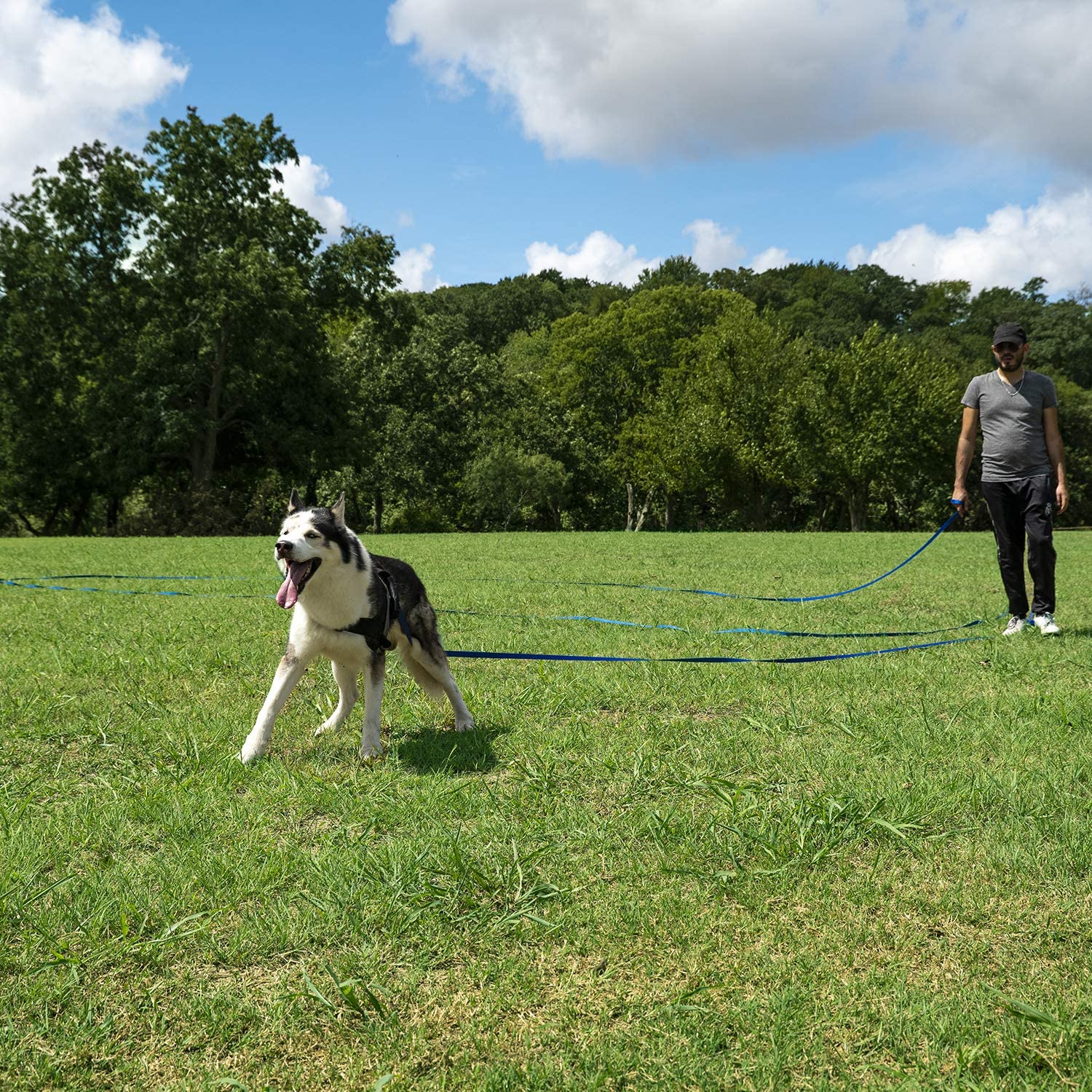
Pit bulls are one of the most loyal and affectionate dog breeds, but they can also be stubborn and difficult to train at times. One of the most important commands for any dog to learn is to come when called, and this is especially crucial for pit bulls, given their powerful build and potential for mischief.
In this article, we’ll explore some effective strategies for training your pit bull to come when called, including positive reinforcement, consistency, and patience. With a little bit of effort and dedication, you can teach your pit bull to be a well-behaved and obedient companion.
Note: For a complete training, we highly recommend this SpiritDog Online Training Course “Coming When Called”.
1. Start with a Strong Foundation
Before you begin training your pit bull to come when called, it’s crucial to establish a strong bond with your pet. Spend time playing with your dog, engaging in activities they enjoy, and providing positive reinforcement through praise and treats. Building trust and a strong connection with your pit bull will make them more likely to respond positively to your commands.
2. Choose a Distinct Command Word
Select a specific word or phrase for the recall command, such as “come” or “here.” Ensure that the command is distinct from other commands you use and that all family members use the same word consistently. Consistency is critical to avoid confusing your pit bull and ensuring that they understand what you expect from them.
3. Begin Training Your Pit Bull in a Controlled Environment
Start training your pit bull to come when called in a controlled, distraction-free environment like your home or a fenced yard. In the early stages of training, it’s essential to minimize distractions to help your dog focus on learning the new command. As your dog becomes more reliable in responding to the recall command, gradually introduce distractions and practice in various environments.
4. Use Positive Reinforcement with Your Pit Bull
When training your pit bull to come when called, always use positive reinforcement techniques. Reward your pup with praise, treats, or playtime when they respond to your recall command. This will help create a positive association with the command and motivate your dog to respond consistently. Remember to be patient and consistent in your training, as it may take time for your dog to master the recall command.
If you’re using treats, these are currently the most popular training treats on Amazon.
5. Gradually Increase Distance and Distractions
As your pit bull becomes more reliable in responding to the recall command in a controlled environment, begin to increase the distance between you and your dog during training sessions. Practice calling your dog from various distances and gradually introduce distractions, such as other dogs, people, or toys. This will help your dog learn to respond to the command even in challenging situations.
Related: Looking for the fastest way to train your pit bull to come when called? Try this video course.
6. Make Yourself Interesting and Rewarding to Your Pit Bull
To encourage your pit bull to come when called, make yourself more appealing and rewarding to your dog. Use an enthusiastic, high-pitched voice when calling your dog, and reward them with a treat or praise when they respond. You can also try running away from your dog when calling them, as this can entice your dog to chase after you and respond to the recall command.
7. Never Punish Your Pit Bull for Coming When Called
It’s essential to avoid punishing your pit bull if they do not immediately respond to the recall command or if they come to you slowly. Punishing your dog can create a negative association with the command and make them less likely to respond in the future. Instead, be patient and continue to practice and reinforce the command using positive reinforcement techniques.
8. Practice the Recall Command Regularly with Your Pit Bull
Consistent practice is crucial for training your pit bull to come when called. Incorporate recall training into your dog’s daily routine, and practice the command in various environments and situations. This will help reinforce the behavior and make it more reliable over time.
9. Use a Long Training Leash on Your Pit Bull
When transitioning from a controlled environment to a more open space, consider using a long training leash to maintain control over your pit bull while they learn to respond to the recall command. This will help you avoid losing control of your dog and provide a safety measure as you gradually increase the distance and distractions during training sessions.
This is the most popular long training leash on Amazon.
10. Be Patient and Persistent with Your Pit Bull
Training your pit bull to come when called takes time, patience, and persistence. Some dogs may learn the command quickly, while others may require more time and consistent practice. Be patient with your dog and maintain a positive attitude during training sessions. Remember that every dog is unique, and the key to success is consistent practice and positive reinforcement.
11. Use a Professional Online pit bull Training Course
While this article provides many helpful tips for training your pit bull, you can increase your chances of success by enlisting the help of a professional online dog trainer. We love the SpiritDog online courses, since its includes unlimited questions with a real dog trainer.
You can check out their Teach Your Pit Bull to Come Online Course Here
In conclusion, training your pit bull to come when called is an essential skill that can improve both their safety and your peace of mind. By using positive reinforcement techniques, consistency, and patience, you can teach your pit bull to respond to your commands and come back to you, no matter what distractions may be present. Remember to reward good behavior, practice regularly, and stay calm and patient, even if progress is slow. With dedication and effort, your pit bull can become a well-trained and obedient companion that you can trust and enjoy spending time with for years to come.
More Frequently Asked Questions For Training Your Pit Bull
Pit Bulls are a breed of dog that is often misunderstood due to their reputation for aggression. However, with proper training and socialization, Pit Bulls can be loving and loyal pets. As a Pit Bull owner, you may have several questions about how to train and care for your furry friend. In this article, we will address some of the most frequently asked questions about training your Pit Bull.
1. How can I train my Pit Bull to stop biting?
Biting is a common problem among Pit Bulls, especially when they are puppies. If not addressed, this behavior can lead to serious injuries later on. Here are some tips for training your Pit Bull to stop biting:
Start early: It’s important to start training your Pit Bull as early as possible. Puppies have a natural urge to bite and chew, and they learn to control this behavior through training.
Provide plenty of chew toys: Pit Bulls need to chew, and providing them with plenty of appropriate chew toys can help redirect their biting behavior.
Teach the “leave it” command: The “leave it” command can be used to redirect your Pit Bull’s attention when they start biting. Begin by placing a toy or treat in front of your dog and saying “leave it.” When your dog stops biting, reward them with a treat or toy.
Use positive reinforcement: Positive reinforcement is an effective training technique for Pit Bulls. Whenever your Pit Bull exhibits good behavior, reward them with a treat, toy, or praise.
Never use physical punishment: Physical punishment can make your Pit Bull aggressive and fearful. Instead, use positive reinforcement to encourage good behavior.
2. How can I train my Pit Bull to walk on a leash?
Walking on a leash is an essential skill for any dog, including Pit Bulls. Here are some tips for training your Pit Bull to walk on a leash:
Start indoors: Begin by practicing indoors where there are fewer distractions. Attach the leash to your Pit Bull’s collar and let them drag it around while you supervise.
Use a harness: A harness can give you more control over your Pit Bull while you are walking. It can also prevent your dog from pulling and choking themselves.
Use positive reinforcement: Positive reinforcement is an effective training technique for walking on a leash. Reward your Pit Bull with a treat, toy, or praise whenever they walk calmly on the leash.
Keep the leash short: Keeping the leash short can give you more control over your Pit Bull. Hold the leash close to your body and avoid letting your dog pull you.
Be patient: Learning to walk on a leash takes time and patience. Don’t expect your Pit Bull to master this skill overnight.
3. How can I train my Pit Bull to be friendly with other dogs?
Pit Bulls have a reputation for being aggressive towards other dogs. However, with proper socialization and training, they can learn to be friendly and social with other dogs. Here are some tips for training your Pit Bull to be friendly with other dogs:
Start early: Socialization should begin as early as possible, ideally when your Pit Bull is a puppy. Expose your dog to a variety of people and dogs to help them become comfortable around others.
Supervise playtime: Supervising your Pit Bull’s playtime can prevent aggressive behavior towards other dogs. Always intervene if your dog shows any signs of aggression.
Use positive reinforcement: Positive reinforcement is an effective training technique for Pit Bulls. Reward your dog
4. What’s the best online course for teaching a pit bull to come when called?
At iHeartDogs, we recommend the SpiritDog online course “Coming When Called.” The course includes unlimited questions with a real dog trainer.
- 7 Best Online Dog Training Courses 2023
- SpiritDog Training Review - Is It Worth The Price?
- Brain Training for Dogs Review 2023
- K9 Training Institute Review 2023
- 6 Best Online Training Courses to Teach Your Dog Not to Pull on Leash
- 6 Best Online Training Courses to Teach Your Dog to Stop Resource Guarding
- 6 Best Online Dog Training Course for Potty Training
- 6 Best Online Dog Training Courses to Teach a Dog Not to Jump On People
iHeartDogs is reader supported. Our articles contain affiliate links where we are paid a small commission for linking to a product at no additional cost to the reader.



 Toledo, United States.
Toledo, United States.